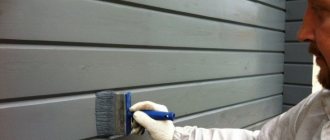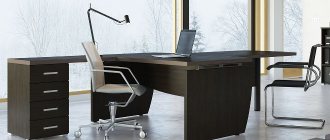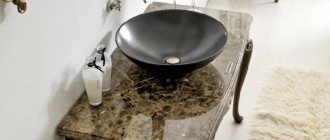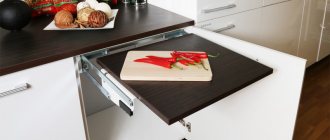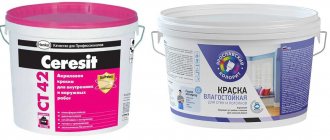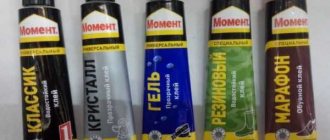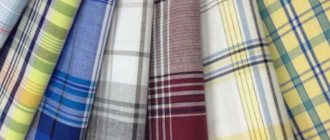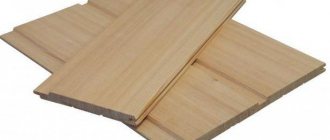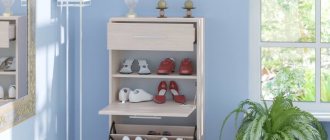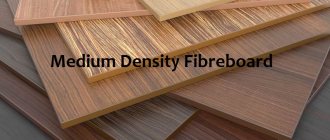Being an inexpensive option for paint and varnish products, alkyd paint has gained particular popularity among consumers. The wide selection on the market, combined with the possibility of application to almost any surface, has ensured high demand for the alkyd group of materials.
To make the right choice and understand all the nuances of working with paints of this type, you need to have an idea of their varieties, scope of application and technical characteristics.
Paint composition and properties
The basis of any alkyd paint is a special varnish and a solvent that allows you to obtain the desired consistency. A variety of fillers that provide certain properties and additives (for example, a protective antiseptic) are also used. Pigments give paint the desired color.
The alkyd-based varnish used in the production of paint can be glyphthalic or pentaphthalic. For the manufacture of paints, pentaphthalic varnish is mainly used, which consists of alkyd resins mixed with vegetable oils, glycerin and rosin. Solvent is added to thin the paint.
The properties of the material depend on the specific type of product. After application and complete drying, it may have:
- increased degree of density of the protective layer;
- excellent water-repellent properties;
- resistance to mechanical damage;
- resistance to aggressive detergents and cleaning agents.
In addition, alkyd paint for metal can impart anti-corrosion properties to the metal; over time, the treated surface does not lose its original color and does not turn yellow.
A wide range, affordable price and ease of use are another plus in the treasury of advantages of paints of this type.
It is worth remembering that the toxicity of paint at the stage of its use is quite high; many will not like the strong smell of the material. However, after the treated surface dries, the environmental issue is removed and the harmful effects are reduced to zero.
The presence of solvents in alkyd paints makes them a fire hazard, so operation requires strict adherence to safety measures.
How to apply enamel
Unsplash
Before starting work with the substance, read the instructions on the packaging. You also need to prepare a mask, protective clothing and gloves. The composition is rarely used in its pure form; more often it is diluted before application.
How to dilute alkyd enamel
- White Spirit. Oily liquid with a pungent odor of gasoline. This solvent is suitable even for the thickest mixtures.
- Turpentine. It used to be the most popular solvent. Has the same characteristics as white alcohol.
- Xylene. Almost transparent or yellowish solvent. It can also be used as a degreasing mixture for surfaces.
- Solvent. A colorless liquid that not only dilutes the product, but can also clean and degrease.
- Solvent 646. This type is most often used for diluting varnishes and paints. It gives the coating a special glossy effect, helps the solution form a dense and high-quality film on the surface, thereby greatly simplifying the work.
How to calculate consumption
To understand how much mixture you will need for finishing, you need to take into account several details. Pay attention to the thickness of the initial solution. The thicker the mixture, the more solvent it will need.
Unsplash
The number of layers applied will depend entirely on the quality of the surface. If you are coating metal, the solution consumption may increase. Please note that after applying each layer it must be allowed to dry for 24 hours.
Consumption also depends on the type of work. So for interior decoration, the cost is always higher than for exterior repairs.
Features of application
The scope of application of alkyd paints directly depends on the composition of the paint and varnish material. Solvents, being an integral component, provide a high degree of adhesion to almost any surface: wood, metal, brick, etc.
The coating formed as a result of applying paint not only provides high-quality protection from external aggressive influences, but is also capable of stopping processes that have already begun in the material being processed (for example, corrosion, if we are talking about metal). There are compositions that do not require additional cleaning of the surface being treated.
Alkyd paint for wood allows you to process internal and external structures, and the presence of an antiseptic additive provides reliable protection for wooden elements.
In addition to narrowly targeted paints, there are universal options on sale that are suitable for treating many surfaces: from concrete to metal.
Preparing for coloring
There are many ways to remove old paint, including using a hair dryer or a special composition, after treatment with which it softens and is easily removed with a spatula. The latter option requires the mandatory use of protective equipment, since most of these compounds are toxic.
Three ways to remove old paint
Even if the packaging indicates that the composition can be applied to old paint, you will still have to remove flaking particles. To seal cracks with a depth of more than 1 mm, you will need wood putty; uneven places also need to be sanded.
How to putty a wooden surface
After which a primer is applied, which will help reduce paint consumption, improve adhesion and extend the life of the wood.
Applying primer with a brush
Important! It is necessary to dry the primed parts thoroughly (preferably for several days), since alkyd compounds do not tolerate application to a wet surface. It is not recommended to paint wood after rain, as the coating may crack. The moisture content of the material can be measured with a special device. It should not be higher than 17%. Optimal – 14%. If fungus is present, the affected areas are dried and treated with special compounds.
GF-230
This paint is based on glypthal varnish and can only be used indoors. Basically, it is applied to all surfaces except the floor, since constant mechanical stress leads to abrasion of the applied layer.
GF-230 should be diluted with white spirit or turpentine so that the density meets the requirements. The color range is quite wide. When working, you can use either a brush or a roller; a spray bottle also gives good results.
The drying time of the alkyd paint of the brand in question is determined by environmental conditions, especially air temperature. The maximum period is one day.
Required Tools
Alkyd compositions are recommended for painting frames, entrance doors, trim and facades of wooden houses. When working with paints, you must use personal protective equipment: goggles, a respirator, gloves, and also observe safety precautions. If the composition gets on your skin, you must immediately remove it by wiping it off with a cloth and rinse the contaminated area under plenty of water.
For coloring you will need:
- alkyd paint;
- solvent (for degreasing wood and thinning paint);
Solvent for alkyd paints
- rags or fabric napkins;
- putty to eliminate large irregularities;
Wood putty
- tools: brushes, rollers or spray gun, spatula, cuvette;
- wood primer;
Wood primer for painting - tips for choosing
- masking tape;
- sanding block and sandpaper.
Sanding block
Before using the alkyd composition you need:
- pre-clean the surface of old paint and dirt;
- degrease it;
- sand with fine-grained sandpaper;
- get rid of dust.
Important! Alkyd paints are highly flammable, so they should not be used near an open fire.
Prices for wood preservatives
Impregnation for wood
PF-115
A universal version based on pentaphthalic varnish is suitable for treating almost any surface. The best protective properties are achieved by applying two layers. Alkyd gloss paint is available in 24 shades, and the shine lasts for a long time. Complete drying lasts from 8 hours to a day.
PF-126
This type of enamels comes complete with a special composition (NF-1), the purpose of which is to speed up the drying process.
To obtain a high-quality result, use a roller or brush when applying. The work is carried out twice, creating thick layers. The drying time of the first is approximately 40 minutes. Thick paint can be thinned using white spirit.
Quick-drying, odorless paint for interior work - main types, selection tips and benefits of useThe best aerosol paint in cans - main types, application features and advantages of use
The best water-based paint - ranking of the best manufacturers of 2018
Film former
An important component of enamel is the film-forming component. Such additives can be etrifthalic, pentaphthalic, xyphthalic.
Pigment
This is a special powder that makes alkyd paint opaque and acquires color. Can be either organic or inorganic. In addition to decorative, they perform a protective function.
Filler
Fillers are designed to make the paint more durable, viscous and opaque. The composition can contain silicates and carbonates. Organic fillers are also used as more dispersed ones.
Additives in the composition
Additives perform various functions, make the drying process faster, and increase the stability and plasticity of the composition. The stabilizer will evenly distribute the paint and prevent it from flaking.
PF-223
The paint and varnish material does an excellent job of creating a durable protective film on heating radiators. Resistance to high temperatures is one of the main properties of this product. The layer dries within 30-36 hours.
The paint is classified as very caustic, so manufacturers recommend using a respirator during work. The solvent for PF-223 is gasoline and solvent.
Matte options
In addition to glossy products, matte alkyd paints are also available on the market. They are used for indoor and outdoor work.
The matte surface looks impressive; among other characteristics, it is resistant to mechanical stress and is not afraid of moisture, oil and aggressive cleaning agents. There are variants of compositions operating in the range from -50°C to +60°C.
Aerosol products
Aerosol alkyd paint is available in special cans and is very convenient to use. It can be used to treat almost any surface and hard-to-reach areas, and the drying speed (about 5 hours) allows you to quickly start using painted elements.
How to choose façade paint for exterior use - a review of popular manufacturers and a rating of the best paints for exterior useWhich oil paint is better - a review of the best brands and criteria for selecting paints
The best interior paint for walls - 2022 rating and instructions for using interior paint
Manufacturers
Among the best manufacturers of alkyd paints, the leading positions are occupied by foreign products of the Tikkurila brand.
Imported paints and varnishes are more expensive, but they often contain only high-quality components. For example, Miranol enamel (Tikkurila) has passed many tests and can even be used to paint children's wooden toys.
The cost of domestic analogues is lower, but some brands are significantly inferior to foreign ones in terms of quality. Containers for paint and varnish products in our country are metal and plastic containers of different sizes.
In the photo, alkyd paint looks different - it can be bright, saturated colors with a glossy sheen or an even matte tone.
The choice will be correct if many nuances are taken into account, from the cost of the product to its shelf life. It is worth remembering that fresh paint in the hands of a master gives the best result.
paints and varnishes
0 votes
+
Vote for!
—
Vote against!
There are a great variety of alkyd enamels. This paint coating is distinguished by its versatility, abrasion resistance, and bright colors. It can be used for both interior and exterior work, and due to the fact that alkyd enamel paint can be glossy, matte, or semi-matte, its scope of application is almost limitless.
Content:
- Composition of alkyd enamels and their properties
- Features of alkyd enamels
- Classification of alkyd enamels
- Alkyd enamel GF-230
- Alkyd enamel PF-133
- Alkyd enamel PF-115
- Alkyd enamel PF-223
- Alkyd enamel PF-253
- Alkyd enamel PF-126
- Matte enamels
- Aerosol enamels
- Manufacturers of alkyd enamels
Composition of alkyd enamels and their properties
Alkyd enamels are made on the basis of alkyd varnish and various solvents with filler. In addition, they contain coloring pigments that give the coating a certain color. Sometimes the manufacturer may include various additives in the combination, for example, antiseptics that protect the painted surface from mold and fungal infections. The main solvent for alkyd enamels is white spirit. By the way, this is what you should use if the paint has thickened. And the fillers are usually sand, granite or marble chips and other materials that have the same properties. Fillers for paint and varnish coatings should not be confused with traditional sand and crumbs - their grinding is much finer and the structure of these materials is more similar to flour.
The most important component of alkyd enamels is alkyd varnish, which comes in two types: pentaphthalic and glypthal. Most often, in the production of paints, pentaphthalic varnish is used, which is a thick solution of resin in a solvent with the addition of vegetable oils, rosin and glycerin. The finished varnish is later mixed with a solvent to form an alkyd enamel.
Features of alkyd enamels
The features of alkyd enamels include their high elasticity and durability. Such coatings dry quickly enough, which allows them to be used indoors without much concern. In addition, such paints do not turn yellow when dry, do not lose their color, or shrink.
They are also suitable for outdoor work, since they have high weather resistance - snow, rain, and temperature changes are not a problem for alkyd enamels.
This type of paint coating perfectly protects various metal surfaces (doors, windows, radiators, furniture, etc.) from corrosion; it is also able to withstand wet cleaning with conventional detergents and can be used in bathrooms, saunas and swimming pools.
Classification of alkyd enamels
Depending on the classification, alkyd enamels have different properties, methods and areas of application. Each brand has its own alphanumeric code, which allows you to determine whether the enamel belongs to a particular category. For example, alkyd enamel PF-120 matte white is deciphered as follows: PF - pentaphthalic (these letters indicate the substance that is used in the paint as a base); the number 1 means that the enamel can be used for outdoor work, and the number 20 is the catalog number.
In addition to the unit, other numbers can be found on alkyd enamels: the number “ 0 ” indicates alkyd primer enamel, that is, a coating intended for priming surfaces;
2 — enamel for indoor use (heated and unheated);
3 — conservation paints, that is, paints and varnishes that are intended for temporary sealing of any equipment;
4 - waterproof paints;
5 — special paints with special characteristics (rodent repellent, glow in the dark, etc.);
6 — oil and petrol resistant enamels;
7 — paints that can withstand chemical attack;
8 — heat-resistant paints;
9 — electrically conductive and electrically insulating paints.
Alkyd enamel GF-230
In this case, GF is glyphthalic. This paint is intended only for interior painting of ceilings and walls. It cannot be used for painting floors, since it does not withstand physical influences well. Before you start using the enamel, it must be diluted to the desired consistency with white spirit or turpentine. There are quite a few shades of glyphthalic enamel GF-230, ranging from light cream to dark colors. It can be applied with a brush, roller or spray. It dries in about a day and has a distinct varnish smell.
Alkyd enamel PF-133
It is used for painting metal surfaces or surfaces that have been pre-primed. It is usually applied in two layers, since its covering ability is not too high (ranging from 20 to 120 g/m2). Dries in 2 hours and comes in 15 subtle shades. In temperate climates, PF-133 enamel retains its protective properties for 5-6 years, and it does not crack or deform.
Alkyd enamel PF-115
Designed for exterior painting of metal, wood and other surfaces. This enamel needs to be applied in two layers, since its covering ability is not too high (30-120 g/m2). Available in 24 shades, applied by spray or brush, drying from 8 to 24 hours. Alkyd glossy enamel PF-115 has a pleasant shine, giving the surface a bright, rich color.
Alkyd enamel PF-223
Its scope of application is interior finishing of wooden and metal surfaces. This alkyd enamel is perfect for radiators - it has 17 shades to suit every taste, hides old paint well and withstands high temperatures well. Diluted to the desired consistency with solvent, gasoline or xylene. Drying time 30-36 hours. The smell is specific, pungent.
Alkyd enamel PF-253
Scope of application: pre-primed plank floors. Apply in two layers using a wide or medium brush. Diluted with turpentine or gasoline. Dries quickly (drying time depends on the thickness of the layer and the temperature inside the room). After drying, the surface acquires an even, flawless gloss.
Alkyd enamel PF-126
This type of enamel is sold complete with NF-1 filler, which accelerates hardening. Apply the paint with a brush or roller in two thick layers with intermediate drying of 30-40 minutes. Before application, the surface is primed with enamel diluted with white spirit.
Matte enamels
Sometimes matte alkyd enamel may be required to paint surfaces. As a rule, such paint is intended for both exterior and interior use. It is durable, resistant to water, detergents, and oils. Able to withstand temperature fluctuations from -50 to +60o C. It is economically consumed, as it has a high covering ability (90-180 g/m2). Diluted with solvent or white spirit.
Aerosol enamels
Aerosol alkyd enamel is easy to use, since there is no need for brushes and rollers, it fits well on any surface and dries very quickly (3-5 hours). It is able to penetrate into any cracks, so it is recommended to paint hard-to-reach places, and the scope of application of such paint is very wide: from garden furniture to stucco on the ceiling.
In addition to the above, there are other types of alkyd enamels, the purpose of which also applies to painting walls, ceilings, floors and other surfaces both outside and inside the house.
Manufacturers of alkyd enamels
On store shelves you can find a huge assortment of alkyd enamels, both Russian and foreign. How do the former differ from the latter?
Firstly, the majority of Russian manufacturers do not rely on packaging: paints are “packed” either in metal or plastic cans. Imported enamels, as a rule, have bright, attractive packaging that distinguishes “overseas” products from their Russian neighbors.
Secondly, a price of 200-300 rubles per liter jar is clearly not suitable for high-quality alkyd enamel, and these are the price tags that are sometimes found on shelves with Russian products. Imported analogues are many times more expensive.
Thirdly, expensive imported enamels contain only the highest quality components that have passed all kinds of tests. It is due to such “ingredients” that enamels produced abroad have virtually no odor, dry quickly, have a huge number of shades and are well distributed over the surface, leaving no streaks or smudges. For example, Tikkuril alkyd enamel "Miranol" is ideal for painting furniture, window frames, doors and even children's toys - its level of safety is so high. It is not yet possible to say something similar about Russian enamels, although our manufacturers have recently been trying to pay as much attention as possible to the environmental friendliness of their products.
When buying alkyd enamel, you should pay attention to its shelf life - the fresher the paint, the better and smoother the coating will be. Well, the most important thing is that you don’t need to chase cheap or expensive - choose the “golden mean” - you definitely won’t go wrong!
